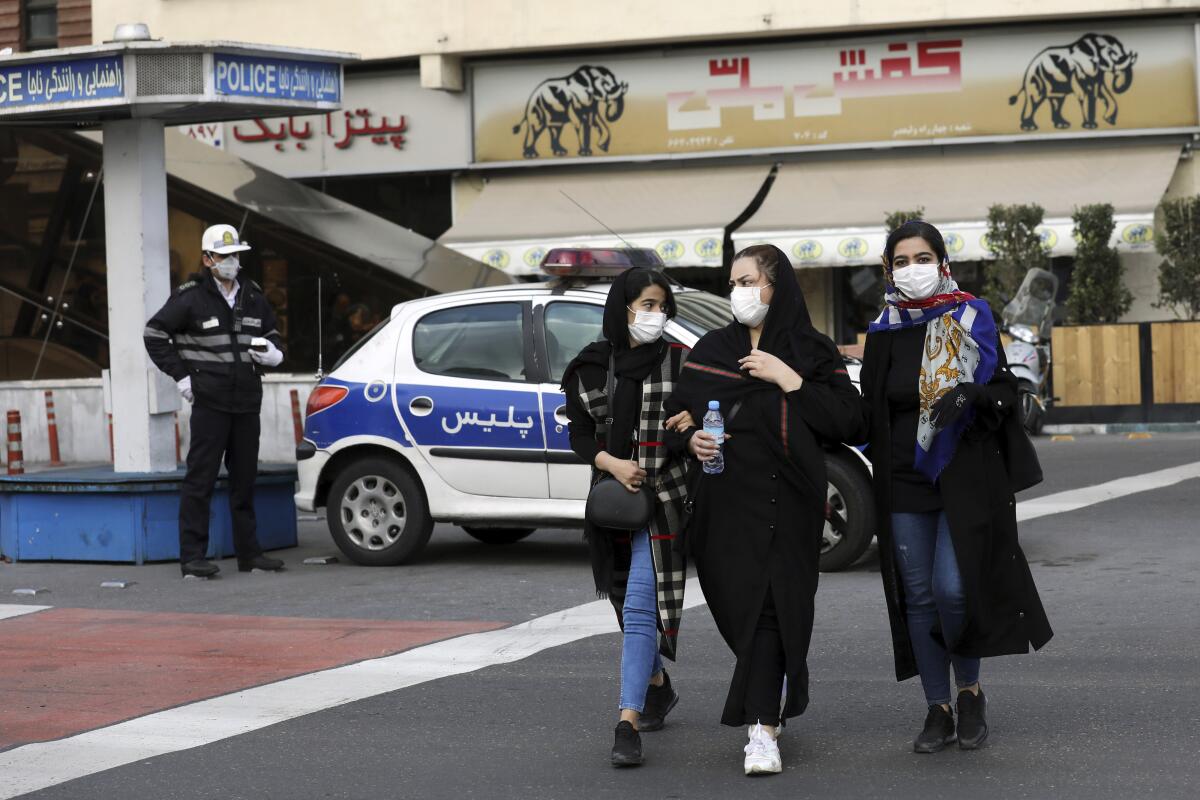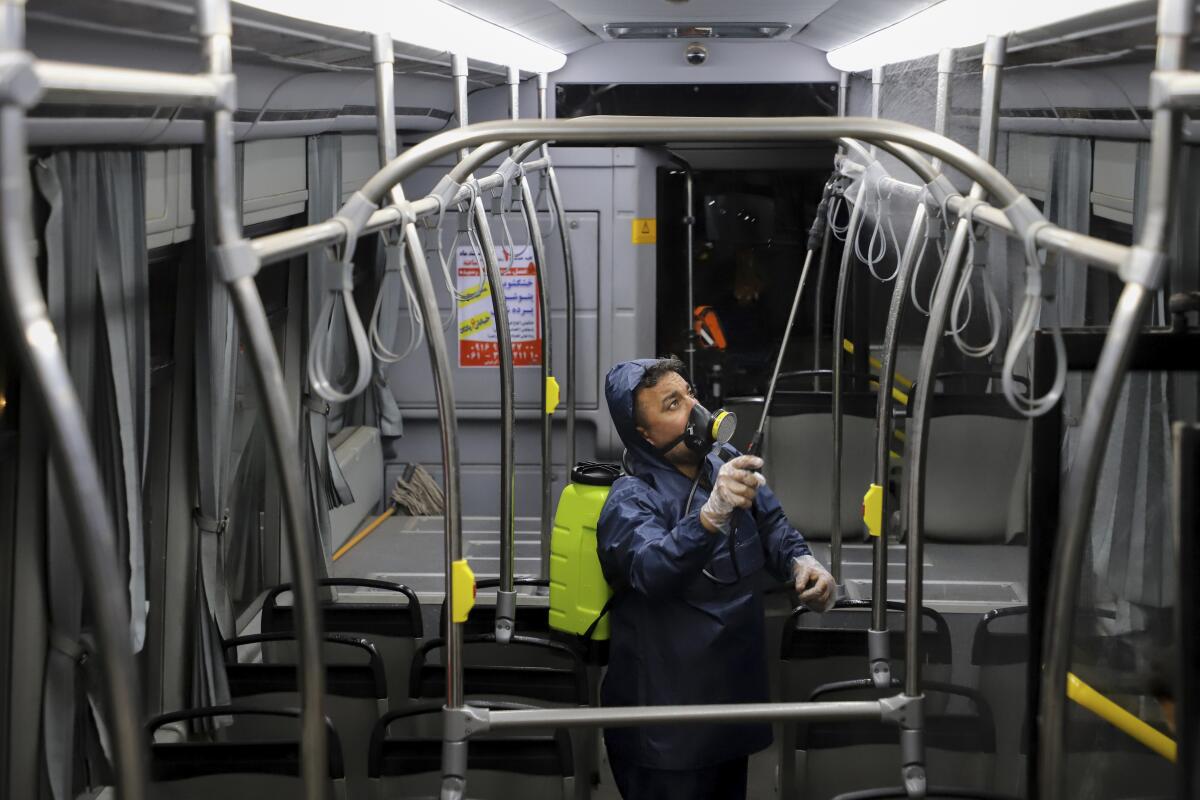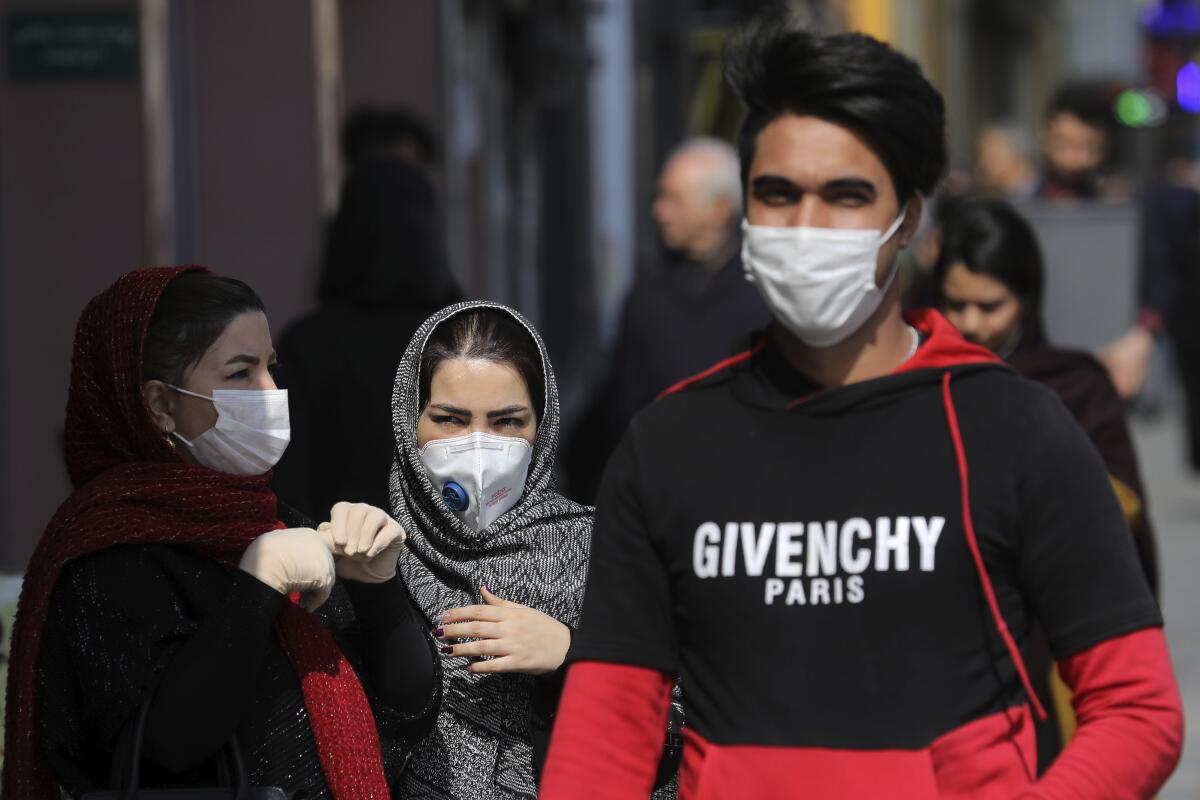How Iran became a hot zone for coronavirus in Middle East

Like many Iranians scared about contracting the deadly coronavirus, Omid Rahimi has been reading the news, tracking rumors and watching television for updates, which, in these unsettled times, has left him only more confused over what to believe and whom to trust.
With fears over a rapidly rising death toll, along with disclosures that several well-known government officials have died, the 28-year-old English tutor is nearly broke after frightened students canceled their classes. Rahimi has decided to leave Tehran and return to his hometown in Qeshm, an island in the Strait of Hormuz.
“Everything is getting scary. People don’t know what to do. The government is not doing anything,” he said. “I’d rather be with my loved ones because I feel safer.”
The coronavirus outbreak has erupted into the Islamic Republic’s latest image crisis. With public trust plummeting around the government cover-up in January of accidentally shooting down a Ukrainian passenger jet, the government’s handling of the virus outbreak is a critical test not only for its healthcare industry but also for its political legitimacy in a time of deepening anger and protest.
So far, the nation’s leaders appear to be stumbling.
Escalating deaths coupled with conflicting reports about the numbers of infected reaffirm the Islamic Republic’s cycle of lies, mismanagement, corruption, inefficiency and cover-ups. The country’s reputation was further damaged when neighboring Arab countries, fearing infections would spread across the Middle East, late last month banned flights to and from Iran.
Mistrust — tinged with unnerving irony — was heightened in the early days of the outbreak, when Iraj Harirchi, Iran’s deputy health minister and head of Iran’s counter-coronavirus task force, announced he had tested positive for the virus.
“I wanted to tell you that I got [the coronavirus],” he said in a video he appeared to have taken himself in late February. “I had a fever as of last night and my preliminary test was positive around midnight. I have isolated myself.”
That his announcement came a day after he appeared sweaty, pale and coughing in a televised news conference that sought to downplay the public health risks, has left an already anxious public further on edge about the Islamic Republic’s competency and transparency.
“My main sense is fear because we have no confidence in the system,” said Maryam Mohammadi, 31, a sociologist from Tehran. Mohammadi has quarantined herself at home for several days because she has asthma.
“We have been oppressed for years. We have been lied to. We have lived in an unequal and unjust society and we have been taught to think for ourselves,” she said. “In the situation of mass crises, there is nothing called ‘society’ that we can rely on to stand against calamity.”

In the two and a half weeks since the first outbreak in Iran was announced, several prominent politicians have died, including newly elected member of parliament Fatemeh Rahbar and Hussein Sheikholeslam, a former advisor to Foreign Minister Mohammad Javad Zarif, according to state news agency IRNA.
The virus has also infected more than 20 current and former Iranian officials, including government spokesman Ali Rabiei, reformist lawmaker Mahmoud Sadeghi and Mojtaba Rahmanzadeh, a district mayor in Tehran.
“I have very little hope to survive,” Sadeghi wrote on Twitter.
On Saturday, Kianush Jahanpur, the spokesman for Iran’s Ministry of Health, said on state-run TV that the coronavirus has so far killed 145 people and infected 5,823 in Iran.
Some people, including lawmaker Ahmad Amirabadi Farahani, have accused government officials of covering up the true number of people infected and dead.
Farahani is from the holy city of Qom — a revered site for Shiite pilgrimage and the country’s coronavirus epicenter. Health Ministry official Minoo Mohraz said that the source of the virus was probably from Chinese nationals who work in Qom and had traveled to China recently, according to the state-run IRNA news agency.
The virus quickly spread to other cities across the country, including Tehran, Babol, Arak, Esfahan and Rasht. It accelerated just as Iranians went to the polls Feb. 21 in parliamentary elections. Since then, officials have shut down schools, universities and cultural centers.
“It’s possible that it exists in all cities in Iran,” Mohraz said.
Iran’s neighbors, including several of its regional allies — Iraq, Lebanon, the United Arab Emirates, Bahrain, Kuwait, Oman, Afghanistan — suffered outbreaks that were linked to Iran.
Yet not all have been able to stop the flow of travelers, especially during pilgrimages for the region’s Muslims. And several of those countries, saddled with crumbling health systems, sclerotic bureaucracies or civil unrest are ill-equipped to contain the threat. One of the most vulnerable is Iraq, which receives a quarter of its imports from Iran and where tens of millions of Iranian pilgrims travel every year for visits to Shiite shrines.

On Feb. 25, Iraq reported four coronavirus cases involving a family in Kirkuk province that had returned from Iran. A day earlier, an Iranian student in the city of Najaf had tested positive for the virus. Iraq’s authorities scrambled, closing schools and universities, canceling large gatherings, and even restricting access to the Imam Ali mausoleum in Najaf, one of the country’s holiest sites.
As of Saturday, the number of confirmed cases in Iraq had risen to 54, and the number of deaths to four.
Lebanon, home to a significant Shiite community, had announced Feb. 21 that a 45-year-old woman returning from Qom to the Lebanese capital, Beirut, had tested positive for the virus. But it wasn’t until four days later that the government declared it would restrict flights to countries with outbreaks and stop all pilgrimage flights.
Back in Iran, authorities are distributing free masks at transportation hubs. The streets of Tehran are quiet and nearly empty of cars, with people choosing to quarantine themselves at home. On TV, stations are running round the clock interviews with health experts and officials.
Mohammad Bagherzadeh, a 33-year-old Tehran-based health reporter at Shargh newspaper, said it is increasingly difficult to get accurate information about the virus.
“The head of the ministry’s public relations department did not respond to me even once this week,” he said. “People believe that the government has failed to properly monitor the coronavirus and has been unprepared to control it.”
Meanwhile, the government has pivoted to its de facto strategy blaming the outbreak on outside actors, including the West. Iranian President Hassan Rouhani said Iran’s enemies are trying to create panic about the coronavirus to shut down society.
“We will get through the virus,” Rouhani promised.
As a result of U.S. imposed economic sanctions, Iran’s economy has faltered, leading to high inflation on basic goods and medicine. Medical staff worry hospitals are not equipped to handle outbreaks; others say authorities have failed to take adequate preventive measures to contain the virus.
John Nicholls, a pathologist at University of Hong Kong, shares those same worries given the country’s ability to access medical supplies in light of sanctions President Trump reimposed following his administration’s decision in May 2018 to withdraw the U.S. from the accord that limited Iran’s nuclear programs.
“The access to the medical equipment may not be as great as it would be expected,” said Nicholls. “That is a big concern.”
Bagherzadeh, the journalist, said face masks, hand sanitizer and other goods are becoming scarce. “Access to supplies is virtually unavailable for a wide range of people. The prices of some ingredients, such as ginger and garlic, which people have been advised to use, have multiplied,” he said.
Times staff writer Alice Su contributed to this report from Beijing and a special correspondent contributed from Tehran.
More to Read
Sign up for Essential California
The most important California stories and recommendations in your inbox every morning.
You may occasionally receive promotional content from the Los Angeles Times.











